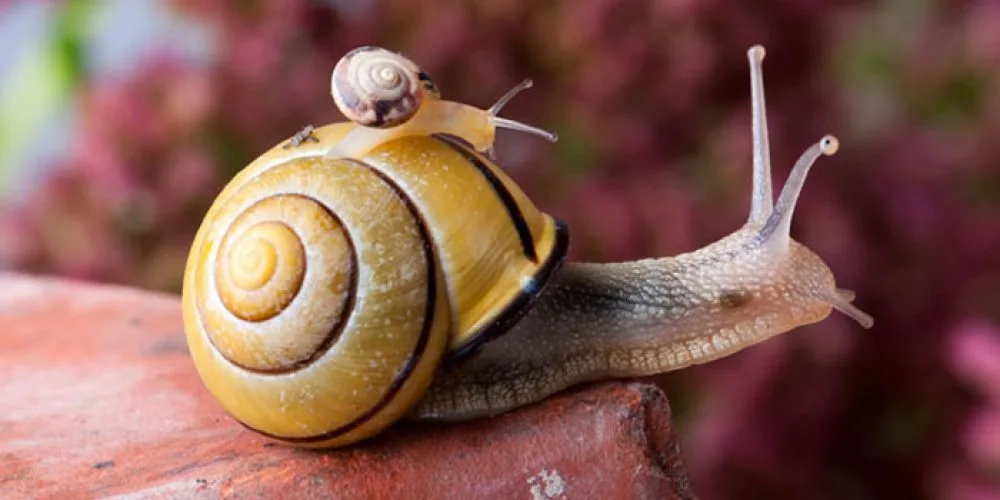“Hurry up! We’re late!” Don’t waste time, hurry up, come here so I can tie your shoes or we’ll be late! “ One more minute, I’ll finish this game and be right over.”
These situations have become an everyday part of our parents-lives: we are all absorbed in an increasingly frenetic and accelerated pace, in the race to do more and more, to achieve and to surpass. And it is precisely this fast pace to which our society forces us that does not align with the slow, natural, unhurried pace that children would like to follow. They know neither haste nor urgency, nor the need to postpone. Their rhythm is determined from within, by the desire to enjoy experiences to the fullest, and forcing this rhythm is very difficult and especially deleterious.
“Story of a snail who discovered the importance of being slow” Fairy tales’ morals inspire often pedagogical reflections. This is the case with Luis Sepulveda’s “The Story of a Snail Who Discovered the Importance of Being Slow” (Guanda 2013), a children’s story with delicate tones that teaches us that in order to savor life’s most precious moments, it is important to move slowly, enjoying each instant. The things we do, our dreams, our questions, everything must be lived without haste, because otherwise we risk that the beautiful moments pass us by, without seizing them. The idea for this book came from a simple question asked to the author by his grandson. Why are snails so slow? asks little Daniel. Here, with his writing full of poetry and gentle irony, Sepulveda makes a critique of our hectic lives by describing a world that is slow, small, but full of details that we should pay attention to. Rebel is the protagonist snail who decides to leave his community -living in a large meadow with slow and repetitive rhythms- to embark on a lonely, and dangerous, journey in search of his own path and uniqueness, and especially to understand the importance of slowness. His contact with many forest animals, especially a melancholy owl and a wise turtle with an important name (“Memory”), leads Rebel to learn the truth, to overcome his fears and to become the voice of a denunciation of isolation and indifference. Thanks to his act of courage, Rebel discovers that his fellow creatures are in danger: man is cutting down vast prairies to turn them into roads and houses. The threat is imminent and our brave protagonist manages to take action, turning slowness into an advantage.
The pedagogy of the snail, the Slow Education Slowness also seems to be a great challenge in schools. A challenge that Gianfranco Zavalloni, pedagogue and school director, author of numerous works on the environment and school time, takes up by elaborating his “Pedagogy of the snail“. A praise of slowness to become aware that it is necessary to slow down to enjoy the simplest and most natural things in life. Rousseau in the Emile said that “You have to know how to lose time to gain time”, affirming that everything that seems to be a waste of time is, on the contrary, a way to favor the learning or the development of children. When we ask a child to hurry up, we violate his right to do things according to his own learning time, we take away his time to learn, a time that is his own, that belongs to him. Adopting the thoughts of the great Swiss philosopher and pedagogue, Zavalloni maintains that the secret of learning lies in knowing how to slow down, at school, but also in the family, in daily life. Above all, “wasting time” talking and listening are the indispensable premises for the development of a correct educational relationship between the teacher and the student, between parents and children. It is not necessary to be in a hurry at school, but to give the students the possibility to blossom in the respect of their own rhythms, manners and learning time. In this way, Zavalloni develops a number of strategies for teaching slowing down that aim to respect and enhance the uniqueness of each child, thus challenging traditional educational practices. Central to this are listening and dialogue with students, especially in the early school years, which are the most important and formative from a personal and relational perspective. In a world where children are already able to organize their lives with smartphones and where technology has taken over traditional games, relationships and studies, it is important to make room for practical learning based on experience: listening to music, the stories of the elderly, going out, learning by touch, playing, gardening…
Thus, in 1994, Zavalloni published the “Manifesto of the Natural Rights of Children“, a selection of rights that should be guaranteed to every child so that he or she can learn with the necessary time, the time he or she needs to grow up. Among these rights, the first one is the right to idleness, which means the right to live moments not foreseen by the adults, and the right to boredom, time during which one does nothing. It would be nice if every school had a poster with the 10 rights listed at the entrance!
The Natural Rights of Children 1. The right to leisure, to live periods of time which are not planned by adults 2. The right to get dirty, to play with sand, earth, grass, leaves, water, pebbles, little branches 3. The right to smell, to indulge in the pleasure of smell to recognize nature’s scents 4. The right to dialogue, to listen and to have the opportunity to speak 5. The right to use their hands, to hammer a nail, to saw and file wood, to use sandpaper, to stick things together, to mold clay, to tie ropes, to light a fire 6. The right to a healthy beginning, to eat wholesome food from birth, to drink fresh water, to breathe clean air 7. The right to the street, to play freely in the square, to walk in the street 8. The right to the wilderness, to build a shelter in the woods, to play hide and seek among reeds, to climb up trees 9. The right to silence, to hear the wind blow, birds sing, water gurgle 10. The right to nuances, to see the sun rise and set, to admire the moon and stars at night








